Museums Doge's Palace | Guggenheim | Correr | Pesaro | Rezzonico | Murano | Accademia | Oriental | Ca d'Oro | Archeological | Querini | Bovolo | Pisani | Fortuny | Rocco | Lace | Marciana | Grassi | Dogana
San Rocco History Art | Location | Opening Hours Tickets | Authorizations
History Art Scuola | Rivalries | Crucifixion | Pilate Ecce Homo Calvary | Official Painter | Snake | Moses Manna | Sin Isaac Jacob | Adoration Temptation Breads | Probatic Pool Last Supper | Olive Garden Resurrection | Pianta | Annunciation Adoration Flight | Innocents Circumcision
Scuola Grande San Rocco Venice - Tintoretto “Christ before Pilate” “Ecce Homo” or “The Coronation of Thorns” and “The Ascent to Calvary”
Thus, from 1566 to 1567, Tintoretto would illustrate three key moments in the Passion of Christ:
Le Tintoretto “Christ before Pilate”
Oil on Canvas (515 x 380 cm) 1566-1567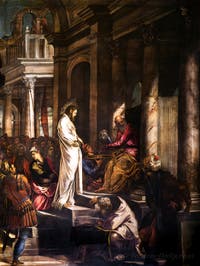
Christ before Pilate This painting is in the Albergo room on the first floor of the Scuola Grande.
The tall stature of Jesus who stands straight and calm in his white cloak full of light contrasts with a Pilate who does not dare look him in the face as he washes his hands, while cowardly pronouncing the sentence impatiently awaited by the dark crowd behind Jesus' back.
The Christ accept with dignity the opportunistic and decisive sentence of the governor sitting at the top of the stairs of his palace.
The secretary of Pilate listens attentively to all the words before writing them down with the eagerness and seriousness of a good civil servant!
Le Tintoretto “Ecce Homo” or “The Coronation of Thorns”
Oil on Canvas (260 x 390 cm) 1566-1567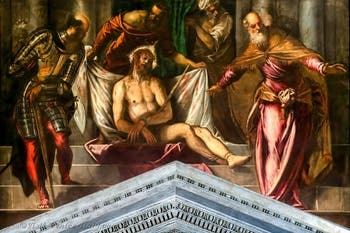
Ecce Homo or the Coronation of Thorns Also known as “The Coronation of Thorns”, this painting is placed above the front door of the Albergo.
The Calvary of Jesus began immediately after the sentence pronounced by Pilate.
Pilate now hands him over to the crowd after he had been scourged and humiliated.
Here he sits on the steps, his body exhausted by suffering pressed against the cloak stained with his blood, his head crowned with thorns and his face full of infinite sadness.
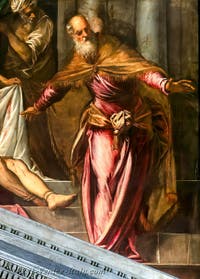
The Coronation of Thorns The light coming from the left of the painting floods the steel of the soldier's armour with coloured reflections, intensifying the reds of Pilate's clothes and the man holding the white cloak behind the body of Christ.
But by contrast, this light also intensifies the vulnerability and suffering of the naked, bloodied body posed there in front of the viewer, arousing his painful compassion.
The Tintoretto “The Ascent to Calvary”
Oil on canvas (5.15 m x 3.90 m) 1566-1567The procession of condemned men stretches along the steep, winding path that leads to Golgotha and divides the painting into two parts:
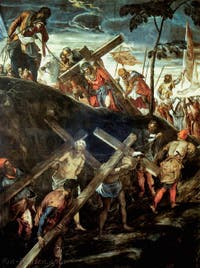
Ascent to Calvary The lower part, very dark, where the two bandits toil half-naked and with ropes around their necks, carrying their crosses, helped by men whose clothes add a few colourful touches.
One of them has stopped, to rest or to protest, perhaps both at the same time; he looks at the man who is helping his companion in misfortune to carry this cursed cross that is bruising his back and crushing him.
They are preceded by their executioners, one pulling on the rope so that they don't drag, the other carrying a hammer on his belt and walking with a determined step, ready to accomplish his task.
Following the zig-zag movement of the path, you reach the upper part in full light, where the disordered crowd moves slowly forward, following a man who stands brandishing a banner, his face raised towards the sky where dark clouds gather.
It could herald the triumphal procession of the many faithful to come, and give a touch of hope to Christ's human pain.
They follow Simon of Cyrene as he helps the Christ about to collapse under the weight of the cross.
A second man has come to help Jesus at the end of his strength, beside them a horseman is attentively following their efforts.
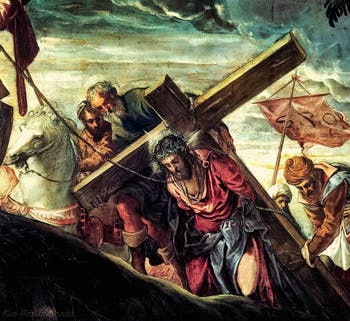
Christ in the Ascent to Calvary A long rope is tied around the neck of Jesus, led like an animal by a gigantic guard who leads the way as he turns around, full of strength and impatience: we are on the eve of a feast day, time is passing and the sky is darkening...
This is how we follow and accompany the unfortunate condemned on the way to their torture: the sinuous movement of our gaze makes us witnesses to the painful march that unfolds before us.
But the drama of Christ's passion represented by these three works reaches its climax in The Crucifixion, where the existential question of faith is posed in its stark reality by the paradox of the incarnate God who accepts the worst human suffering and death for the redemption of Humanity.
In three years, from 1564 to 1567, Le Tintoretto had painted the twenty-three canvases in the Albergo.
History Art Scuola | Rivalries | Crucifixion | Pilate Ecce Homo Calvary | Official Painter | Snake | Moses Manna | Sin Isaac Jacob | Adoration Temptation Breads | Probatic Pool Last Supper | Olive Garden Resurrection | Pianta | Annunciation Adoration Flight | Innocents Circumcision
San Rocco History Art | Location | Opening Hours Tickets | Authorizations
Museums Doge's Palace | Guggenheim | Correr | Pesaro | Rezzonico | Murano | Accademia | Oriental | Ca d'Oro | Archeological | Querini | Bovolo | Pisani | Fortuny | Rocco | Lace | Marciana | Grassi | Dogana
Back to Top of Page

